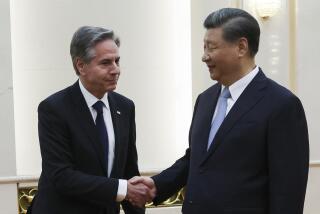The new China syndrome
LIKE NEARLY everything else in the world these days, it now appears that global stock market corrections are made in China. The rout Tuesday that began in China may have been an anomaly, or the start of something big. But I have long felt that something has to give in China. This may be the beginning of an important venting process.
The basic story about China is that despite its remarkable successes on the economic development front, the nation has a seriously unbalanced economy. The main problem is a runaway investment boom.
By Morgan Stanley estimates, fixed-asset investment -- spending on housing, commercial buildings, factories, infrastructure and other property -- exceeded 45% of China’s gross domestic product in 2006. This is a record for China and, in fact, a record for any major economy in the world. By comparison, Japan’s investment ratio in the 1960s -- the period of maximum rebuilding from the destruction of World War II -- never exceeded 34% of GDP. China’s annual growth in fixed-asset investment has averaged 26% over the last four years. Should investment continue to run at this pace, it could lead to a Japanese-style deflation. That’s the last thing China wants or needs.
The Chinese government recognizes the perils of such a possibility. For nearly three years, it has conducted an on-and-off campaign aimed at cooling its overheated investment sector. Following relatively limited actions first implemented in the spring of 2004, Chinese authorities have upped the ante in the last eight months. The People’s Bank of China has raised a key short-term interest rate twice, totaling slightly more than half a percentage point, and beginning in mid-2006, the central bank boosted bank reserve requirements five times, going from 7.5% to 10%, the last such action taking effect last Sunday. The problem for China is that it is still very much a blended economy -- both state and market driven. As such, monetary policy actions have had limited success at best.
Dominated by a vast and highly fragmented system of autonomous local bank branches, much of China’s bank lending remains outside the control of its monetary authorities. As a result, Chinese officials have had to rely largely on “administrative controls” -- a case-by-case approval mechanism -- to rein in the excesses of runaway investment.
The results have been mixed. Fixed investment growth has finally begun to slow, decelerating from near 30% at the start of 2006 to about 14% at the end of the year. Unfortunately, bank lending accelerated. That means China’s central bank has been unable to get traction in reining in bank credit expansion at the same time that the central planners are finally gaining traction in orchestrating an investment slowdown. This has resulted in an excess of bank-funded liquidity that is undoubtedly spilling over into the financial system. As a doubling of the Shanghai A-share index over the last six months suggests, a bubble in the Chinese stock market appears to have been a major outcome of this development.
In China, stability is everything. The Chinese leadership believes that it can’t afford to lose control of either its real economy or its financial markets. Pure market-based systems can rely on interest rates, currencies, fiscal policies and other macro stabilization instruments to contain the excesses. With an undeveloped financial system and the still dominant influence of state ownership, a blended Chinese economy is much harder to control.
Just as China has moved to bring its central planners into the business of containing the excesses in the real economy through administrative measures, I suspect it now feels compelled to rely on a similar approach to deal with excesses in its financial system.
In the last five years, China has emerged as a major engine on the supply side of the global economy. But that has brought a new set of risks -- in particular, an overheated investment sector and an equity bubble. These two problems are very visible manifestations of China’s control problem. The sharp dive of share prices Tuesday may well be symptomatic of China’s increased determination on the macro control front. Ultimately, successful macro control is good news for China and the broader global economy -- it sets the stage for balanced and sustainable growth. But for those counting on open-ended Chinese growth, any such slowdown could come as a rude awakening. The China squeeze now appears to be on in earnest.
More to Read
Inside the business of entertainment
The Wide Shot brings you news, analysis and insights on everything from streaming wars to production — and what it all means for the future.
You may occasionally receive promotional content from the Los Angeles Times.









